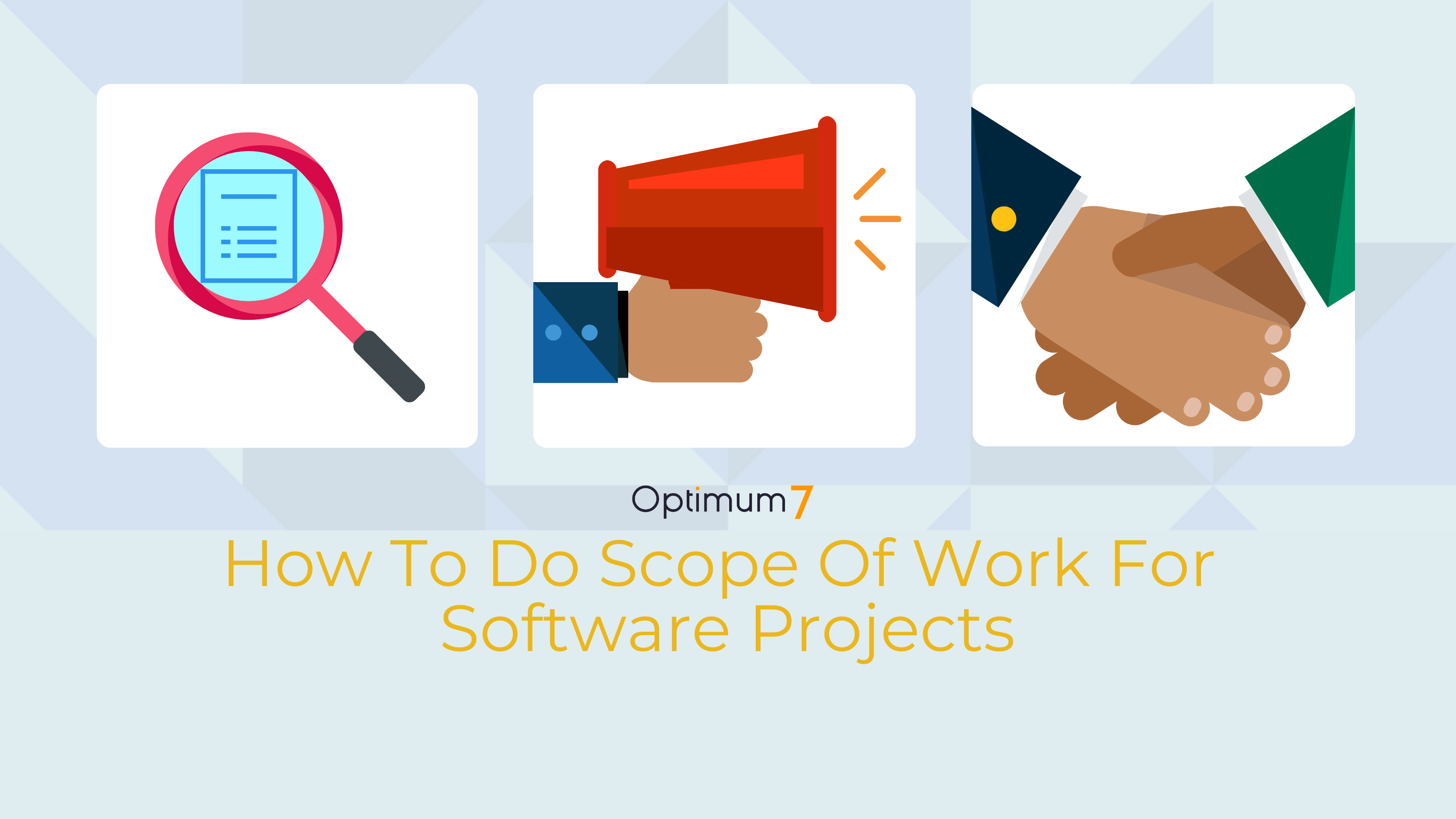There are many reasons why you need to know how to do a scope of work for a software project. Perhaps you don’t have an in-house team to execute that project, or perhaps the time commitment for this type of work doesn’t fit with other tasks that must still get completed in order to keep business moving smoothly. In situations like this, you will need to outsource the project to professionals for a better end product.
But the key to success for any project is communication.
When you communicate your needs, expectations, and intentions clearly from the beginning with those who will work on it there will be fewer surprises down the line.
So how do you prepare a good Scope Of Work that establishes good communication between you and your partner?
Keep reading for an in-depth guide to creating an efficient and comprehensive Scope Of Work.
What Is SOW in Project Management?
Scope of Work 101: What Do You Ask of a Potential Client?
When a prospect comes to you in this manner, what are the first couple of things that you should ask of them?
- What objective are they trying to accomplish?
- What is their business and infrastructure?
- What are their ideal results and timelines?
You want to build out a whole scope program that touches upon all three of these factors.
1. What objective are you trying to accomplish?
2. What is your business and infrastructure?
- Do you have an inventory management system?
- Do you have enterprise resource planning (ERP)?
- Which third-party APIs do we need to integrate with?
Once we nail down the backend side of things, then we’re going to look at the front end. What functionality do I need to build on the front end to make your web app development project possible? These are some of the things that we focus on to produce a scope of work at Optimum7.
3. What are their ideal results and timelines?
Just as important as what needs to be done, you must determine when the prospect hopes to have the final product delivered. Of course, the scope of work may determine that these expectations are unrealistic, but it helps to know what a “home run” might look like.
What is the purpose of a Scope Of Work (SOW)?
The purpose of the SOW is to set expectations, timelines, and other vital criteria that determine the successful completion of a project, contract, or commission.
Every project needs an SOW. If you’re starting your own website or app development company, then it’s time to create one.
The scope of work is a very difficult phase that a lot of people don’t go through and, instead, they just wing it. And it ends up costing them thousands of dollars in the long run.
Worse, they get nothing to show after all the time wasted — and, without an SOW to reference, how would they even know if they did?
Optimum7 has been there, which is why we want you to come to us ready to do it right the first time. Whether you do the project with the same one that did the scope or not, it cannot be overemphasized how important it is for a software developer to have this in order to set the right expectations in budget and timeline.
Here are the steps to create an SOW document for your project:
- Define Your Project
- Setup Tasks for Your Project
- Prepare the Information and Work Templates
- Calculate the Time and Money Costs for Each Task
- Obtain Team Review and Approval
- Request Client Approval
The information that you provide will be used to create a detailed scope of work for your company’s entire project scope. The length and the depth of your SOW document are all up for interpretation. This means it could go on as long as 20 pages in which no small detail is irrelevant.
Write a detailed description. Be specific and clear about your requirements so your service provider can understand. Include a glossary of terms, if necessary, since it might help avoid confusion later on in order to get what you want from this project.
The WBS is a great way to avoid scope creep. Scope refers to what we’re ultimately planning on doing with our project, and it can sometimes be easy for the “scope” or size of the project to change without us noticing (because there are so many steps between now and then).
It helps keep to break down tasks into their component parts. With more specific work packages that have fewer items each, and less detailed larger subtasks which cover broader areas, you’ll find your task lists becoming easier both reading-wise and managing as time goes by.
Scope of work in project management includes deliverables, a timeline, milestones, and reports. Your scope of work should include these categories:
Timeline
The timeline is an important part of any project. It’s used to set expectations on how long the whole process will take and what steps should happen in each phase or milestone — like a calendar for projects!
The final date can change based on input from your trusted service provider.
Milestones
Deliverables
Project deliverables are an important part of any software development project. They give you the assurance that each specific task that’s promised will be delivered. It defines detailed deliverables for future revisions or enhancements to a product’s functionality.
At a general level, deliverables can also be a report, a set of features, a product, key milestones, or whatever you define as the end product.
Reports
Reports are a great way to communicate progress on projects. They allow you and your team members insight into what’s going well and what areas need improvement, which can really help guide future work towards success.
A good report will give an accurate account of how much time has been spent so far without including any confidential information about clients or other stakeholders whose intellectual property may get leaked if included in these reports.
Budget
Budget is an important factor in deciding which provider to use for software development. The more you’re willing and able to spend on a project, the higher quality of workmanship will be expected from your providers as well as their attention to detail throughout each stage or phase of the production process.
You should always do a general budget overview for what you can afford when building out any type of SOW documents. This will have drastic effects with regard to pricing options and also how much control that person has over every aspect including design/design consultation through completion.
General Tasks vs. Individual Tasks:
In order to complete each of these tasks, it is necessary that you write down all general tasks and how much time they will take.
For web or app projects, there are several categories to take into consideration for a project set up:
- Planning and Creating an information architecture
- Discuss the Project Information with the team
- Server / DNS Environment Setup
- Code Repository Setup
- SEO (Search Engine Optimization) Planning
Information Architecture
Launching The Project
Launching a project can be daunting work for project managers. This task might seem easy on the surface, but it’s never as simple or straightforward in reality – especially if you don’t plan for all of its necessary aspects beforehand!
For example, DNS setup. Make sure email management is intact and planned properly, and push files with relevant content to team members who need them before launch day arrives. That way, they’ll know how their workflow should function once launched successfully without any issues.
Post-Launch Tasks
Launching a website or app is just the beginning of your process, not its end. Make sure you can keep clients happy and ensure long term success after launch. Depending on who you’re working with, they may want to add things like testing & validation steps. They may wish to implement approval processes for new projects, such as those that require authorization from managers/owners if there are outside agencies involved.
Budget and Costs
It is crucial for you to understand the total cost of a software project before getting started.
When creating your budget, include detailed information on how much it will take per hour or milestone completion and what kind of payment terms are being offered for the project cost. That way, there won’t be any surprises later down the line.
You always want to know exactly where every penny goes. Furthermore, you don’t want the anxiety of unfinished work costing extra money due to situations outside your control, like weather conditions which can affect construction timelines significantly. With a properly kept budget, you’ll know exactly how to adjust.
Payment Models
There are two other types of payment models for software development-related projects.
A fixed-bid contract is a one-time agreement with the contractor or agency to complete all deliverables.
This model ensures that there are no additional costs for outside resources. Additionally, it empowers the client to secure less-than-market-rate pricing due, in large part, to reduce the risk of the contractor not meeting deadlines (which can sometimes be difficult if not impossible without firm commitments upfront).
This type of contract does have its drawbacks, however. You and the contractor must define project planning to the final detail before any work can be initiated, which can be very difficult to do well. Additionally, since everything has been agreed upon already, there’s little flexibility for changes to happen during the project’s duration — so make sure everything will still work out!
Using a retainer model, you pay for the personnel, along with all other resources related to the project, and will continue making payments on a regular basis to retain these resources until the project is finished.
SOW To Find The Right Partner For Software Development Projects
Developing your SOW before contacting potential partners will help you find a partner that is on the same page.
A written outline with clear instructions and expectations can provide an easy way of guiding these negotiations, ensuring all parties are well acquainted ahead of time.
A good SOW will let software development companies factor in all your requirements to come up with an estimate for your actual project.
They’ll take aspects like the number of engineers needed, technologies used, and complexity into account when they create it so you have more time to think about what needs doing without being overwhelmed by numbers.
The SOW should contain all the information you need to make an informed decision about who will develop your software.
Providers can give a rundown on cost, time frame, and what features are in demand for this type of project – helping rule out candidates early or gain insight into how much their prices might be so that it’s clear whether we’re talking affordable enough!
The technical requirements you include in the SOW will help find a development team with the expertise necessary for your project.
FAQ
How Much Does This Scope-Out Cost?
Most prospects are concerned about this cost. Unfortunately, it really depends.
They typically range anywhere from $5,000 to $20,000, depending, but each project is different — which is the reason that you want to do a scope up in the first place.
Why Should a Client Invest in a Scope-Out?
Without a scope of work, all your client has is an idea. It’s rarely in anyone’s best interest to waste hundreds of thousands of dollars following an idea without form or foundation.
For example, a prospect may take an idea to a development company and the developers quickly agree, provide quotes, and get to work. However, they did nothing to demonstrate that they understand the objectives of the client’s business, the complexity of the project, the details of the tech stack, and the different functionalities required at the backend and frontend.
A scope out enables you, and your prospect, to do the following:
It enables prospective clients to see their idea in a more realized form. It enables you to provide them with a 50- to 100-page-long technical specification that’s going to nail down everything, from payment integrations to single sign-on functionality for customers to create or to log into their accounts on Facebook, Google, or Twitter.
Additionally, it enables the client to take their scope-out document and open it up for bid. By doing this, they can get accurate pricing quotes from different developers.
Finally, it allows you to express value to your prospective client. You’ll be empowered to demonstrate that a scope of work is in their best interest because, in the end, the scope-out process will be more cost-effective and labor-saving than hoping that a developer can summon the right process from an unformed idea.
Conclusion
Scope of work is what defines the success or failure of any project. It’s important to define every detail you can think of, so there are no misunderstandings about your intentions with them later down the project schedule.
In other words: “a written list that tells people exactly how we plan on doing everything”.
Master the Scope-Out Process with Optimum7
Web app development is a fickle industry. Often, the services we provide aren’t understood clearly, and it’s up to us to sell our prospective clients on why these services are invaluable. If you want more strategies for pitching and developing meaningful, value-additive scopes of work, reach out to the Optimum7 team today.














